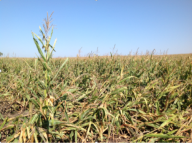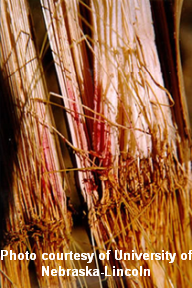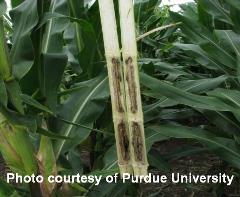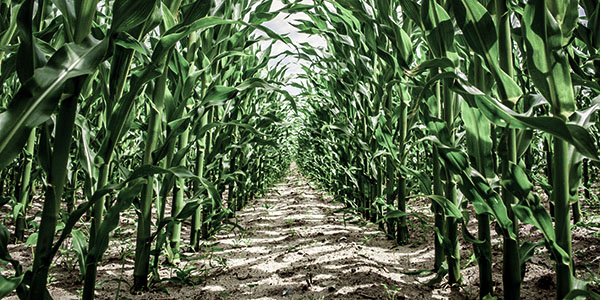AGRONOMICSUPPORT
YOU CAN TAKETO THE FIELD
Manage Stalk Rot to Prevent Stalk Lodging
One thing that seems to be common every year, but to different extents, is stalk lodging caused by the rotting of the stalks. Whether large or small, this seems to be pivotal every year. Lodged plants tend to produce poorly filled ears with low test weight due to the lack of access to carbohydrates the cob needs. Unfortunately, this is more common in the higher yielding hybrids as they produce larger and heavier ears. When the plant is under stress, the larger ears tend to use the carbohydrates the stalk needs, which then weakens the stalk on the plant, thus causing the plant to lodge. Throughout this article, I will touch on a few symptoms of stalk rot and a few different kinds of stalk rot as well.
 The first thing I notice when stalk rot may be a problem is the wilting or discoloration on the leaves of the plant. Stalk rots are caused by organisms that target plants that are already weak because of imbalances in water, hail, insect damage, leaf damage, etc. Something that we are noticing more this year is stalk rot caused by heavy amounts of rain. The stalks become weak, pathogens target the plants that are vulnerable, thus causing them to lodge. Certainly 80 mph winds aren’t ideal on top of the conditions either.
The first thing I notice when stalk rot may be a problem is the wilting or discoloration on the leaves of the plant. Stalk rots are caused by organisms that target plants that are already weak because of imbalances in water, hail, insect damage, leaf damage, etc. Something that we are noticing more this year is stalk rot caused by heavy amounts of rain. The stalks become weak, pathogens target the plants that are vulnerable, thus causing them to lodge. Certainly 80 mph winds aren’t ideal on top of the conditions either.
Two of the more common types of stalk rot are fusarium and anthracnose.
 In hot, dry years, fusarium stalk rot is very common prior to silking and warm, wet conditions following silking, especially in the Midwest. This fungus also causes rotting of the ears but can affect the roots and stalks as well. A few things to look for when trying to find fusarium root rot are a white fungal growth on the outside of the stalk and a pink discoloration inside the rotted stalks.
In hot, dry years, fusarium stalk rot is very common prior to silking and warm, wet conditions following silking, especially in the Midwest. This fungus also causes rotting of the ears but can affect the roots and stalks as well. A few things to look for when trying to find fusarium root rot are a white fungal growth on the outside of the stalk and a pink discoloration inside the rotted stalks.
One of the most common stalk rot diseases in the country and the only one that has a foliar phase is anthracnose stalk rot. The stalks that are infected often are seen to have black, shiny lesions on the outside and inside of the stalk. Some favorable conditions for anthracnose to thrive and spread are cloudy days with high humidity levels after silking. Infections can build up quickly after silking and occur thru wounds in the leaves or stalks  caused by insect feeding or hail. When the lodging occurs, often the stalks break off or tip in the upper part of the plant canopy rather than near the ground, as is common with other stalk rots.
caused by insect feeding or hail. When the lodging occurs, often the stalks break off or tip in the upper part of the plant canopy rather than near the ground, as is common with other stalk rots.
References and additional information:
- https://www.extension.purdue.edu/extmedia/BP/BP-89-W.pdf#targetText=This%20fungus%20also%20causes%20Fusarium,(Figure%207).
- http://extensionpublications.unl.edu/assets/pdf/ec1898.pdf






Technical Team Agronomist